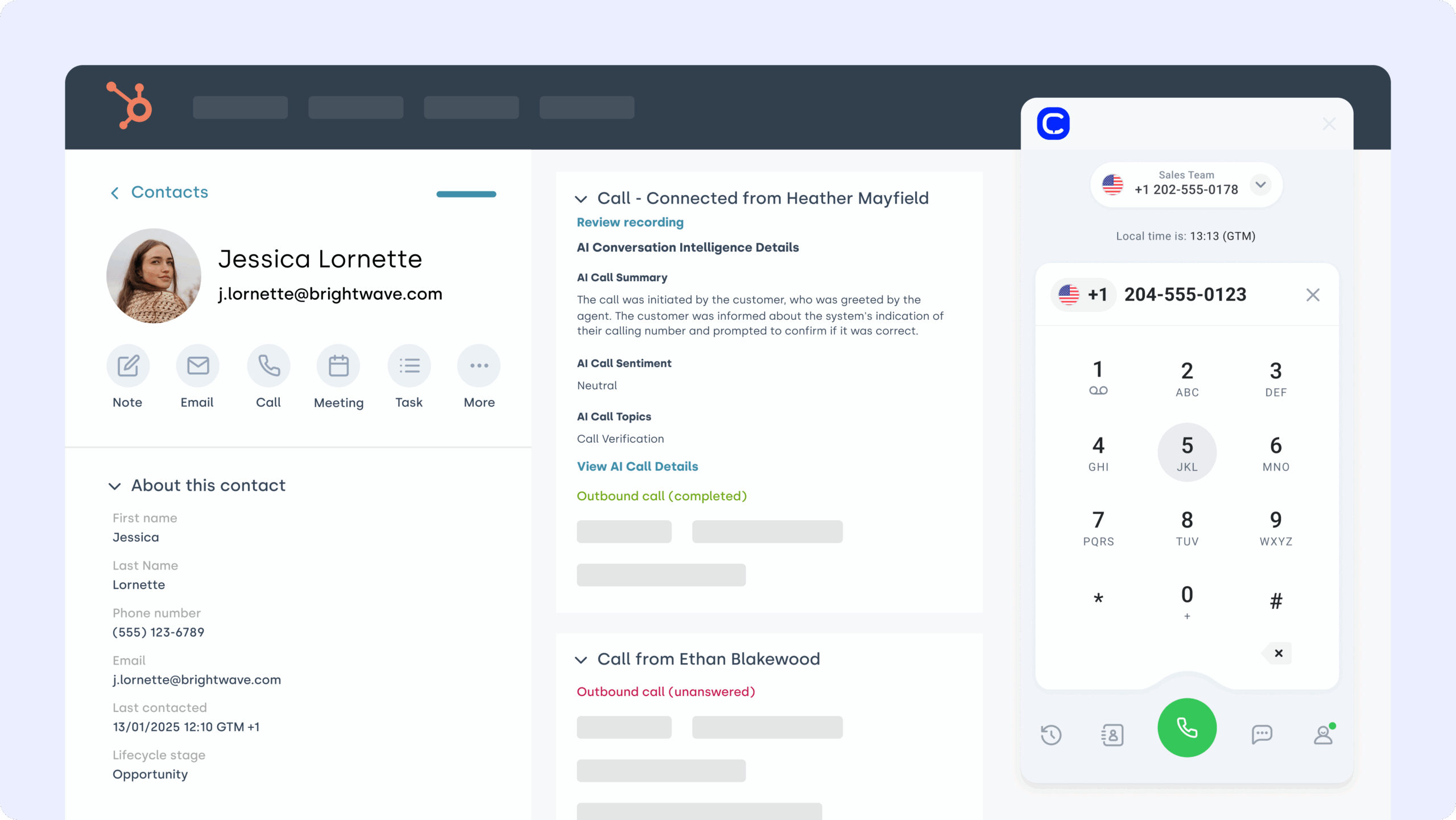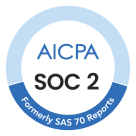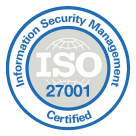In 30 words: RingCentral fits large enterprises that need broad communications tools. CloudTalk is built for fast-moving sales and support teams who want deep CRM automation, faster setup, and simpler workflows inside Salesforce.
Save time, cut down on manual work, and deliver faster, more personalized customer experiences.
That’s what your Salesforce integration should do. Unfortunately, it’s not all up to Salesforce; it also depends on the telephony solution you connect it with.
Both RingCentral and CloudTalk promise a seamless Salesforce integration. They log calls, sync contacts, and help reps stay focused on customers—but they do it in very different ways.
This guide breaks down how each integration works, where teams lose or save time, and which platform delivers the smoother experience for fast-moving sales and support teams.
From the outside, RingCentral looks built for large, multi-channel enterprises, while CloudTalk fits agile sales and support teams that want a lighter, faster, more automation-friendly setup. But once you see how each handles Salesforce, the story gets more interesting.


RingCentral vs CloudTalk: Salesforce Integration Comparison
Integration Summary Table
| Feature / Area | RingCentral for Salesforce | CloudTalk for Salesforce |
|---|---|---|
| Integration Type | AppExchange connector-based integration. Data passes through RingCentral’s platform before syncing to Salesforce | Direct two-way synchronization between CloudTalk and Salesforce every 10 minutes — no middleware required |
| Setup Complexity | Requires admin privileges and manual installation from AppExchange or RingCentral Gallery; only available to Advanced and Ultra plan users | Can be activated from CloudTalk’s dashboard in minutes; setup via Salesforce AppExchange with guided steps and webhook automation |
| Calling Inside Salesforce | Embedded dialer with one-click calling and caller ID (supports RingCentral Video and Meetings) | Native softphone inside Salesforce — agents make/receive calls and SMS without switching tabs |
| Automatic Call Logging | Auto-logs calls and messages but requires verification for accuracy; limited customization of call outcomes | Logs all calls, notes, tags, and outcomes automatically to the right contact, lead, or case in real time |
| Analytics & Reporting | Provides “Cloud Phone Reports” inside Salesforce for call metrics; limited customization options | Includes detailed performance dashboards, call recordings, sentiment analysis, and topic extraction via CloudTalk’s Conversational Intelligence and Salesforce Einstein AI |
| IVR / Call Flow Control | IVR setup requires IT support or admin configuration changes | Self-service visual call-flow designer; teams can adjust IVRs, routing, and queues directly in CloudTalk without support tickets |
| Recording & QA Access | Call recordings accessible via RingCentral portal, not embedded in Salesforce records | Recordings, transcripts, and QA notes stored directly under each Salesforce record for instant access |
| AI & Automation | Includes general AI-powered communication tools; Salesforce Einstein compatibility limited to specific editions | Fully compatible with Salesforce Einstein AI for real-time transcription, sentiment analysis, and call insights |
| Support & Maintenance | Enterprise-level support with slower resolution times; integration updates tied to higher-tier plans | Quick-response support and all Salesforce integration features included on all paid plans — no hidden tiers |
| Ideal Team Size | Mid-to-large enterprises with dedicated IT support and complex UCaaS needs | Small to mid-sized sales and support teams prioritizing automation, flexibility, and speed |
Why Salesforce-Phone Integration is Essential for Fast-Growing Teams
When your phone system and Salesforce aren’t working together, small inefficiencies pile up fast. Here’s what that looks like in practice—and how the right integration turns those daily pain points into time saved and better visibility.
Why Your Team Needs Salesforce Integration
| Without Proper Integration | With the Right Integration |
|---|---|
| Reps spend hours every week logging calls and updating records by hand | Call notes and recordings log automatically—giving reps back hours for selling and follow-ups |
| Customer history isn’t visible during live calls, so conversations start cold | Caller details, deal stage, and past interactions appear instantly, helping agents respond with context |
| Missed or incomplete records make reports unreliable | Every call is captured accurately for analytics, so managers can trust their dashboards and forecasts |
| Managers have to chase updates across tools to see what’s happening | Dashboards update in real time with live call data—giving leaders instant visibility and faster coaching opportunities |
| Teams lose track of follow-ups and duplicate effort | Automated workflows trigger next steps immediately, keeping pipelines moving and customers engaged |
| Disconnected systems slow everything down | Fewer manual steps, faster handoffs, and a smoother customer experience across sales and support |
When you break it down like that, the value of tight CRM integration is obvious. The question now is how each provider delivers it—and that’s where the differences between RingCentral and CloudTalk really start to show.
Overview: RingCentral Salesforce Integration
RingCentral’s Salesforce integration connects its cloud phone system with Salesforce through an AppExchange connector. The setup allows users to place, receive, and log calls without leaving Salesforce—a key selling point for companies that rely on RingCentral for multi-channel communication across voice, SMS, and video.
Core features include:
-
Click-to-call and SMS directly from Salesforce records.
-
Automatic call logging that creates or updates Salesforce tasks with call details (duration, direction, time).
-
Pop-up call notifications for inbound calls, displaying caller details and contact history.
-
Voicemail and fax logging within Salesforce records.
-
Salesforce Cloud Phone reports, which use Salesforce-native reporting tools for call metrics.
RingCentral positions this integration as a fit for mid-to-large enterprises, especially those with complex communication stacks or Microsoft-heavy environments. It’s part of the broader “unified communications” ecosystem RingCentral sells to large organizations looking for central control over multiple channels.
However, the integration itself depends on an additional connector and specific RingCentral plans (Advanced or Ultra tiers). While it enables call activity to appear in Salesforce, it’s not considered native: data passes through RingCentral’s platform before syncing, which can introduce lag, sync errors, or duplicate records if configurations aren’t tightly managed.
For larger teams with dedicated admins, that’s manageable. For smaller or faster-moving teams, it can mean more time spent troubleshooting and less time spent selling.
Next up:
what those pain points look like in real workflows, and why so many users describe the experience as more “connected” than truly automated.
Common User Pain Points with RingCentral Salesforce Integration
TL;DR: RingCentral’s Salesforce integration delivers functional connectivity but requires hands-on management to maintain accuracy and performance. For large enterprises with IT resources, these trade-offs are manageable. For smaller, fast-moving teams, they often translate into extra admin time and higher costs.
RingCentral’s Salesforce integration has some setbacks related to setup complexity, workflow maintenance, and the depth of automation once the system is running.
-
Manual intervention still required: While the integration supports automatic call logging, internal documentation notes that reps often need to confirm or adjust records when syncs don’t execute as expected. The process relies on Salesforce tasks being generated correctly, and missed or incomplete entries can require manual fixes.
-
Reporting and analytics limitations: The integration includes “Salesforce Cloud Phone Reports”, which offer standard metrics like call counts and durations. However, report customization is limited, and more advanced analytics, such as call outcomes or multi-channel attribution, typically require exports or additional setup in Salesforce.
-
Accessing recordings and QA material: Although RingCentral can log voicemails and faxes within Salesforce, call recordings are not always directly linked to contact records. Accessing them can involve navigating through RingCentral’s interface rather than viewing them inside Salesforce, which slows down QA and coaching workflows.
-
IVR and call flow management: RingCentral’s IVR and routing setup is “IT-managed”—meaning teams must submit configuration requests through support or system administrators. Simple routing changes or call-flow adjustments cannot be completed self-serve in Salesforce, which adds turnaround time.
-
Integration design and performance: The connection between RingCentral and Salesforce runs through an AppExchange connector, not a fully native integration. Because data passes through RingCentral’s platform before syncing, this can result in time lags, duplicate records, and additional login steps, particularly when Salesforce or RingCentral updates occur.
-
Support and cost structure: According to the internal battlecard, customers cite slower support resolution times and limited visibility into plan-based feature availability. Certain Salesforce integration capabilities are restricted to Advanced and Ultra plans, which increases total cost of ownership for teams seeking full functionality.
Next up:
How CloudTalk approaches the same integration — built for automation, real-time updates, and flexibility without additional overhead.
CloudTalk Salesforce Integration: Designed for Speed & Automation
“TL;DR: CloudTalk’s Salesforce integration removes the friction points that typically slow teams down — manual syncing, fragmented analytics, and admin bottlenecks — replacing them with real-time visibility and automation built for everyday use.”
CloudTalk’s Salesforce integration was built to eliminate the manual work and lag that slow teams down in other setups. It’s a direct, two-way connection between CloudTalk and Salesforce — no middleware, no extra connectors, and no dependency on IT or support tickets to keep data flowing.
With CloudTalk + Salesforce you get:
-
Real-time, two-way sync: Every call, note, and recording updates instantly and bi-directionally between CloudTalk and Salesforce. Reps see customer details and history before answering, while call logs, notes, and tags are automatically added to the right Salesforce record as soon as a call ends. There’s no need to double-check or re-enter information later.
-
Full visibility, right inside Salesforce: CloudTalk’s softphone sits directly within the Salesforce interface, so teams can make and receive calls without switching tabs or logging in elsewhere. Every interaction — inbound, outbound, missed calls, and voicemails — appears under the correct lead, contact, or case, keeping the CRM truly up to date.
-
Self-service configuration and call flow management: CloudTalk offers a visual call-flow designer, allowing teams to adjust IVR menus, routing logic, or queue priorities in real time — without filing support tickets. This flexibility helps teams adapt faster when priorities or campaigns shift.
-
Complete call visibility for coaching and AI: All recordings and call notes are stored and accessible directly in Salesforce. Managers can replay calls, review outcomes, and track patterns across agents — simplifying training, quality assurance, and performance feedback.
-
Scalable automation and transparent pricing: CloudTalk’s integration is available on every paid plan, with no hidden tiers or feature gates. Setup takes minutes, and the system scales easily as teams grow — meaning you don’t have to upgrade plans or open support tickets just to access core functionality.
Now let’s have a look at what they will be like for your team:
Before and After CloudTalk
| Before CloudTalk (Typical RingCentral Setup) | After CloudTalk Integration |
|---|---|
| Reps log calls manually in Salesforce | Calls auto-logged with notes, contacts, and outcomes |
| Managers rebuild reports weekly | Dashboards update in real time, no manual cleanup |
| Call routing changes need IT tickets | Teams edit call flows instantly via drag-and-drop |
| Reps switch tabs to see customer info | Caller details pop up automatically in Salesforce |
| Missed calls and duplicates pile up | Every interaction synced, no lost data or double records |
| Onboarding takes weeks | Agents ready in hours with guided setup |
| Support waits days for fixes | 24/7 chat and live support with <1h response time |
Real Customer Feedback & Success Stories
CloudTalk’s Salesforce integration isn’t just a feature set — it’s the backbone of how fast-growing teams reclaim time, scale operations, and simplify complex workflows. Here’s how four different businesses used it to do exactly that.
Catch Creation—Handling 66% More Calls Without Hiring More Agents
E-commerce incubator Catch Creation manages multiple consumer brands and peak seasons with call volume surges up to 6,000 daily.
Before CloudTalk, outdated software and rigid contracts held them back. By switching, they gained scalability, visibility, and 4+ years of uninterrupted reliability.
My Mortgage Finder — From Manual Dialing to 100+ Calls Per Agent Per Day
UK-based My Mortgage Finder helps clients with adverse credit secure financing. But their old system — including RingCentral — couldn’t keep up with growth or integrate with HubSpot.
CloudTalk changed that with a Power Dialer, AI analytics, and full CRM integration.
LKN Strategies — 40% Drop in Abandonment, 30% Higher Agent Efficiency
Healthcare BPO LKN Strategies Inc. supports providers, payers, and insurers. Outdated phone systems slowed them down with manual call logging and disjointed tools.
After evaluating RingCentral, 8×8, and Vonage, they chose CloudTalk for its CRM integration, security, and automation.
M4U Holdings — 20% Increase in Productivity and Stronger CRM Automation
M4U Holdings faced dropped calls, fragmented data, and no analytics visibility. After comparing Aircall, Dialpad, and RingCentral, they selected CloudTalk for reliability, API flexibility, and seamless Salesforce integration.
When to Choose CloudTalk Over RingCentral
1. You want accurate data instantly: RingCentral’s call logs sometimes take their sweet time showing up — or worse, show up twice. CloudTalk updates Salesforce in real time, with no duplicates, no lag, and no mystery numbers. You click a lead, you see the calls. Revolutionary, I know.
2. You need the power to make quick changes: CloudTalk’s Call Flow Designer lets you drag, drop and create your own call flow.
3. You want to increase efficiency: CloudTalk logs calls, notes, and recordings automatically — which means your reps spend less time pretending to be data entry clerks and more time talking to actual humans.
4. You want to coach your team: With Whisper Mode and live call monitoring, managers can jump in and guide reps during the call — not in the postmortem. Because “better luck next time” isn’t a coaching strategy.
5: Great customer support is a must: CloudTalk’s support team responds in minutes, 24/7.
Build a Smarter Salesforce Workflow
Salesforce should be your team’s command center—not another app your reps grumble about between calls. The difference comes down to how well your phone system connects to it. CloudTalk was built for teams who need complete integration.
It automates the boring stuff, syncs data in real time, and gives managers instant visibility into what’s actually happening on the phones. Less admin. More conversations. Better outcomes.
If you’re serious about saving time, boosting productivity, and getting the most out of your CRM, it’s time to switch.
[/block]
















